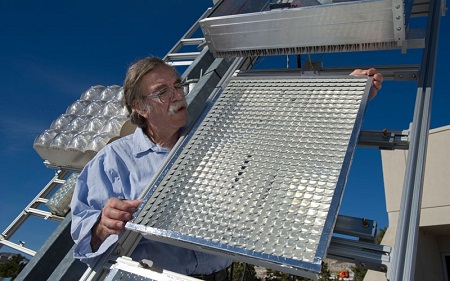Do The Math—the nom de plume of UC San Diego physics smart guy Tom Murphy—argues persuasively that we’re all a bit too focused on photovoltaic (PV) efficiency. Even at 15 percent, he says, PV is beating a lot of other energy technologies and “is perfectly adequate for our needs.” But in the hyper-competitive world of solar PV, where a few percentage points improvement could cut costs, boost investor support and improve marketability, the battle for greater efficiency rages on. Alta Devices and Semprius are the latest to claim new efficiency records.
Santa Clara, Calif.-based Alta Devices said its “most recent solar panel has been verified by the National Renewable Energy Laboratory (NREL) at 23.5 percent efficiency.” The company said “this is the highest solar panel efficiency yet achieved and demonstrates Alta’s progress toward its objective of developing solar photovoltaic (PV) solutions that are competitive, without subsidies, with fossil fuels.” Meanwhile, Durham, N.C.-based Semprius said it had “set a new world record for photovoltaic module efficiency, reaching 33.9 percent.” (That’s a Semprius prototype pictured directly below.)

Now, you might have noticed that these two records are quite disparate, with more than 10 percentage points separating them. How can that be? A quick review of the different ways people talk about solar efficiency records explains how.
The first thing to keep in mind is a lot of the efficiency records you hear bandied about are for cell efficiency. Cells are the most basic form of the solar photovoltaic apparatus, the building block, if you will. But to generate usable electricity in a real-world scenario, cells need to be combined to form modules, AKA panels. The efficiencies with panels are inevitably lower than with a single cell.
In this case, both Alta Devices and Semprius were talking about modules/panels, so at least we’re on the same page there. (Last November, we wrote about Alta Device setting a cell efficiency record.)
But then there’s the matter of the category of PV technology. On this count, comparing the Alta Devices record to the Semprius record is kind of like comparing apples and oranges. Or, to put it less metaphorically, it’s like comparing panels made from thin-film-crystal gallium arsenide (GaAs) single-junction cells to high-concentration PV (HCPV) GaAs triple-junction cells.
Each type has its pluses and minuses. The big plus for the Semprius module is its extraordinary efficiency—but the downside is that making HCPV cells is more expensive, and to function well the panels need to use a system to track the sun as it moves across the sky. More added expense. But on the manufacturing count, at least, Semprius claims a proprietary process to “print” its incredibly tiny cells (the smallest in the world at the size of a pencil point, according to the company).
The NREL, which worked with Semprius in developing its technology, explained the process: “Semprius engineers use the company’s patented micro-transfer printing process to allow the micro-cells to be transferred from the growth substrate to a wafer. In a massive parallel process, thousands of cells are transferred simultaneously. This allows the original substrate to be used again and again, dramatically cutting costs. It also provides a way to handle very small cells.”
Alta Devices, too, touts a less-expensive way to work with GaAs. Key to the process are cells “about one micron thick; for comparison, a human hair is approximately 40 microns thick.” The company says that “in utilizing very thin devices that have the highest energy density possible, the cost of the material needed in Alta panels remains low and the potential costs of an entire solar energy system based on Alta’s technology could be dramatically reduced.”